This section will describe the major anatomic structures of the respiratory system, including the nose and adjacent structures, pharynx, larynx, trachea, bronchia, alveoli, and lungs. Common disorders affecting these structures will also be introduced.
Nose, Nasal Cavity, and Sinuses
See Figure 4.2[1] for an illustration of anatomic structures of the upper respiratory system. The upper respiratory system refers to the nose, nasal cavities, sinuses, pharynx, and larynx. An upper respiratory infection (ŬP-er RES-pĭr-ă-tō-rē ĭn-FEK-shun) (URI) refers to a viral infection of one or more of these structures.
The entrance and exit for the respiratory system are through the nose. The nostrils are the opening to the nose, also referred to as nares. The nares and nasal cavities are lined with mucous membranes, containing sebaceous glands and hair follicles that serve to prevent the passage of large debris, such as dirt, through the nasal cavity. The word root for “nose” is rhin. For example, rhinorrhagia (rī-nō-RĀ-jē-ă) refers to bleeding from the nose, also called epistaxis (ĕp-ĭ-STĂK-sĭs). Rhinitis (rye-NYE-tis) refers to inflammation of the nasal mucosa. The nares open into the nasal cavity, which is separated into left and right sections by the nasal septum (SĔP-tŭm). The floor of the nasal cavity is composed of the hard palate and the soft palate. The nasal cavities are lined with mucous membranes that produce mucus (MŪ-kŭs), a substance created for lubrication and protection. Rhinorrhea (rye-noh-REE-uh), commonly referred to as a “runny nose,” is medical term for excess mucus production by the nasal cavity. Adjacent to the nasal cavity are the sinuses that serve to warm and humidify incoming air. There are four sinuses named for their adjacent bones: frontal sinus, maxillary sinus, sphenoidal sinus, and ethmoidal sinus. Sinusitis (sī-nŭ-SĪ-tĭs) refers to inflammation of the sinus cavities. Air moves from the nasal cavities and sinuses into the pharynx.[2]
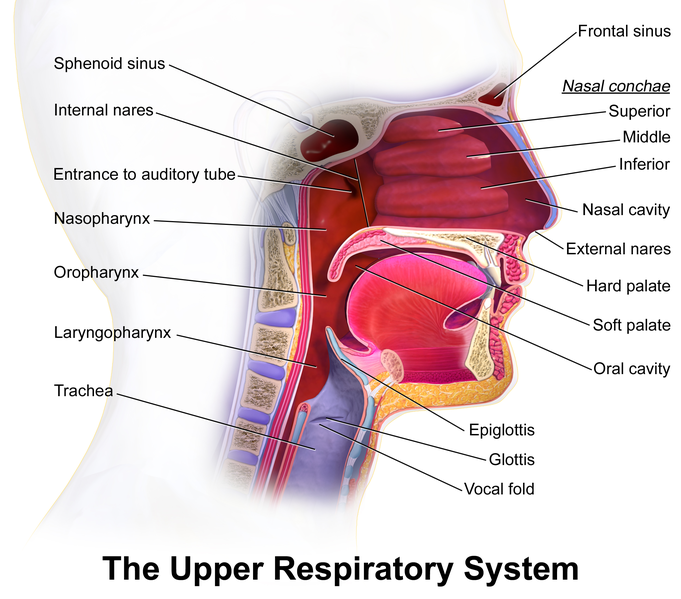
The pharynx (FĂR-ĭngks), commonly known as the throat, is divided into three major regions: the nasopharynx, the oropharynx, and the laryngopharynx. See Figure 4.3[3] for an illustration of the regions of the pharynx.
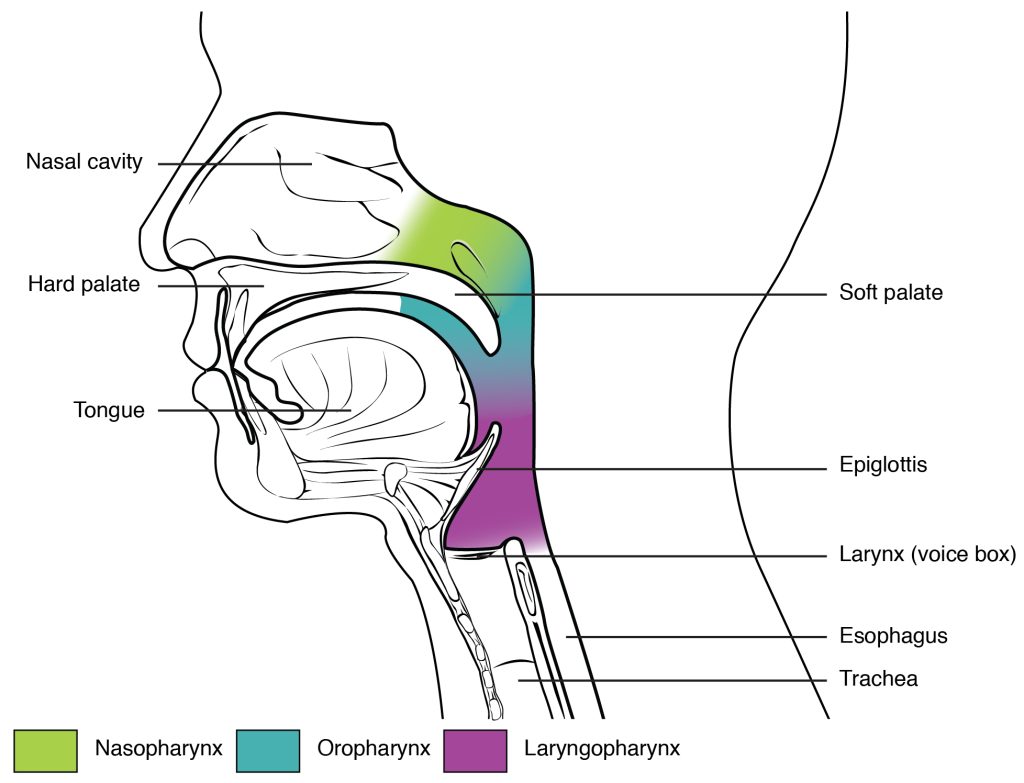
At the top of the nasopharynx is the pharyngeal tonsil, also called adenoid, which is collection of lymphatic tissue found at the back of the nasal cavity in the nasopharynx. The function of the pharyngeal tonsil or adenoid (ĂD-ĕ-noyd) is to trap and destroy invading pathogens that enter the airway during inhalation. Pharyngitis (fă-RĬN-JĪ-tĭs) is inflammation of the pharynx. Tonsillitis (tŏn-sĭl-Ī-tĭs) refers to inflammation of the tonsils. Adenoiditis (ad-ĕ-noyd-ĪT-is) refers to inflammation of the adenoids, a common medical condition in young children that can hinder speaking and breathing.[4]
The soft palate and a bulbous structure called the uvula swing upward during swallowing to close off the nasopharynx to prevent ingested materials from entering the nasal cavity. Eustachian tubes connect the middle ear cavities with the nasopharynx. This connection is why colds can sometimes cause ear infections in children.[5]
The oropharynx is bordered superiorly by the nasopharynx and anteriorly by the oral cavity. The oropharynx contains two distinct sets of tonsils called the palatine tonsils and lingual tonsils that also trap and destroy pathogens entering the body through the oral or nasal cavities.[6]
The laryngopharynx is located just below the oropharynx. It is the part of the pharynx (throat) located behind (posterior) the larynx. The laryngopharynx separates into the trachea (the tube going to the larynx) and the esophagus (the tube going into the stomach). The epiglottis prevents food and fluid and food from entering the trachea while swallowing.[7]
Larynx
The structure of the larynx (LĀR-ĭngks) is formed by several pieces of cartilage, as shown in Figure 4.4.[8] Three large cartilage pieces form the major structure of the larynx called thyroid cartilage (the larger piece of cartilage on the anterior side), epiglottis (at the top of the larynx), and cricoid cartilage (just inferior to the thyroid cartilage). Laryngitis (lă-rĭn-JĪ-tĭs) refers to inflammation of the larynx, specifically the vocal folds or cords, resulting in huskiness or loss of one’s voice and a cough.[9]

The epiglottis (ĕ-pĭ-GLŎT-ĭs) is a flap of tissue that covers the trachea during swallowing to prevent aspiration (ăs-pĭ-RĀ-shŭn), the inhalation of food or fluids into the trachea and lower respiratory tract. The act of swallowing causes the pharynx and larynx to lift upward, allowing the pharynx to expand and the epiglottis of the larynx to swing downward, closing the opening to the trachea.[10]
Vocal cords are white, membranous folds attached by muscle to the cartilages of the larynx on their outer edges. The inner edges of the vocal cords are free, allowing oscillation as air passes through to produce sound for speaking. See Figure 4.5[11] for an illustration of vocal cords. The word root phon refers to sound or voice, so the medical term dysphonia (dis-FŌ-nē-ă) refers to the medical condition of difficulty speaking (i.e., voice).[12]
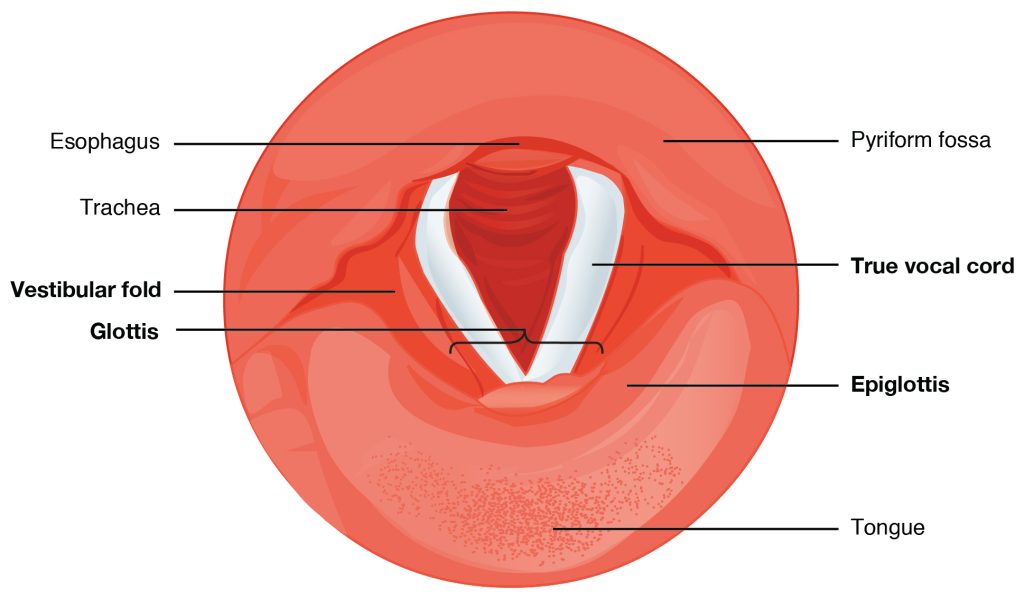
The lower respiratory tract consists of the trachea, bronchi, alveoli, and lungs.
The trachea (trā-KĒ-ă) is formed by stacked, C-shaped pieces of cartilage that are connected by dense connective tissue. See Figure 4.6[13] for an illustration of the trachea. The trachea stretches and expands slightly during inhalation and exhalation, whereas the rings of cartilage provide structural support and prevent the trachea from collapsing. The trachea is lined with cilia and mucus-secreting cells to trap debris and move it towards the pharynx to be swallowed or spit out.[14]

If the upper respiratory tract becomes blocked with mucus, inflammation, or a foreign object, no air can pass to the lungs, causing a life-threatening emergency. A tracheostomy (trā-kē-ŎS-tō-mē) is an incision created in the trachea to create an artificial opening to allow breathing when an obstruction is present.
Bronchi and Bronchioles
Bronchi (brŏng-kī) are the main air passageways of the lungs. The trachea branches into the right and left primary bronchi at the carina. The carina is a raised structure that contains specialized nervous system tissue that induces violent coughing if a foreign body, such as food, is present. Rings of cartilage, similar to those of the trachea, support the structure of the bronchi and prevent their collapse. The bronchi of each lung continue to branch up to 26 times creating the bronchial tree, which looks similar to the branching of an actual tree.[15]
Bronchioles (brŏng-kē-ŏlz) are the smallest branches of the bronchi that lead to the alveolar sacs. See Figure 4.7[16] for an illustration of the terminal (very last) bronchioles leading to the alveolar sacs. The muscular walls of these tiny bronchioles do not contain cartilage like those of the bronchi, so the muscular wall can change the size of the bronchia to increase or decrease airflow to the alveoli.[17]
The word root bronch refers to the bronchi. Bronchospasm (brŏng-kō-spăz-ăm) is a symptom of many respiratory conditions that refers to a sudden constriction of the muscles in the walls of the bronchi. Bronchitis (brŏng-KĪ-tĭs) refers to inflammation of the bronchi. Bronchoscopy (brŏng-KŎS-kŏ-pē) is a procedure in which a tube is inserted by a medical specialist to visually examine the bronchi.[18]
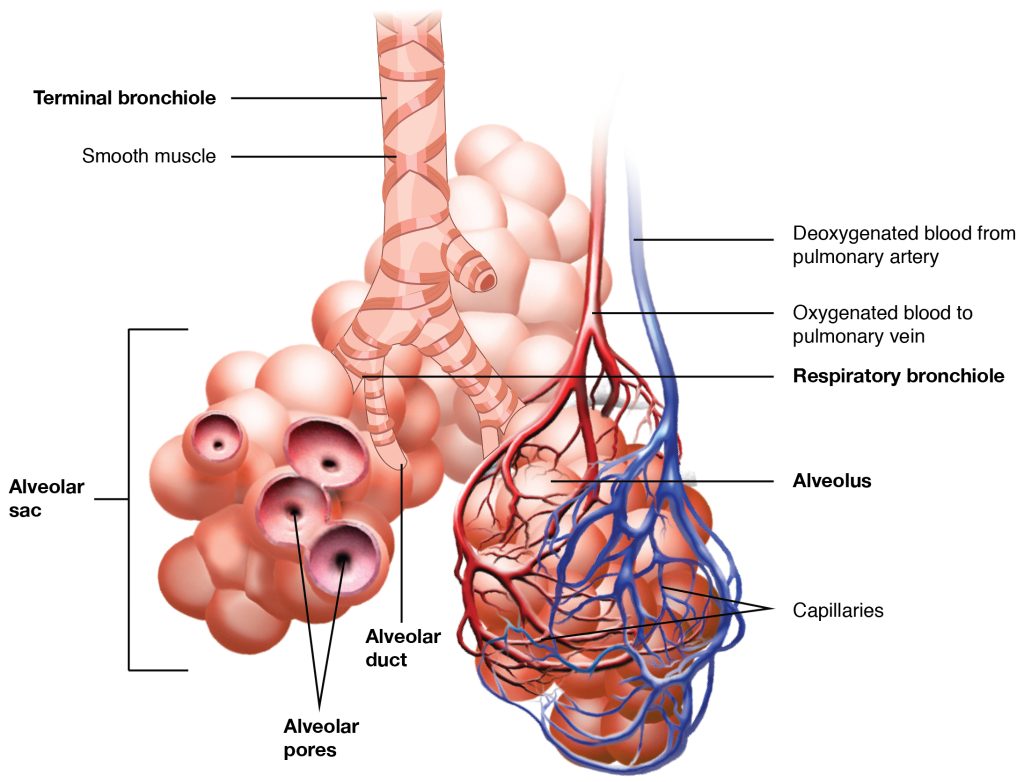
The trachea, bronchi, and bronchioles are lined with mucous membranes that create mucous secretions that can be expelled through the mouth, also referred to as sputum (SPŪT-ŭm).
Alveoli
Alveoli (ăl-VĒ-ŏ-lī) are small, grapelike sacs where gas exchange occurs. Alveoli have elastic walls that allow the alveolus to stretch during air intake, which greatly increases the surface area available for gas exchange. Alveoli secrete surfactant (SŬR-făk-tănt), a slippery substance that prevents the lungs from collapsing. Atelectasis (ă-tĕ-lĕk-TĀ-sĭs) is a medical term that refers to the collapse of alveoli and/or small passageways of the lungs that can result in a partially or completely collapsed lung.[19]
Alveol is the root word for alveolus, the singular form of alveoli. For example, the medical term alveolar (ăl-VĒ-ŏ-lăr) means pertaining to the alveolus. [footnote]This work is a derivative of Anatomy and Physiology by OpenStax licensed under CC BY 4.0. Access for free at https://openstax.org/books/anatomy-and-physiology/pages/1-introduction[/footnote]
Lungs
The lungs (lŭngz) are connected to the trachea by the main (primary) bronchi that branches to the right and left bronchi. See Figure 4.8[20] for an illustration of the lungs. On the inferior surface, the lungs are bordered by the diaphragm. The cardiac notch, a medial indentation found only on the left lung, allows space for the heart. The apex of the lung is the superior region, whereas the base is the distal region near the diaphragm.[21]
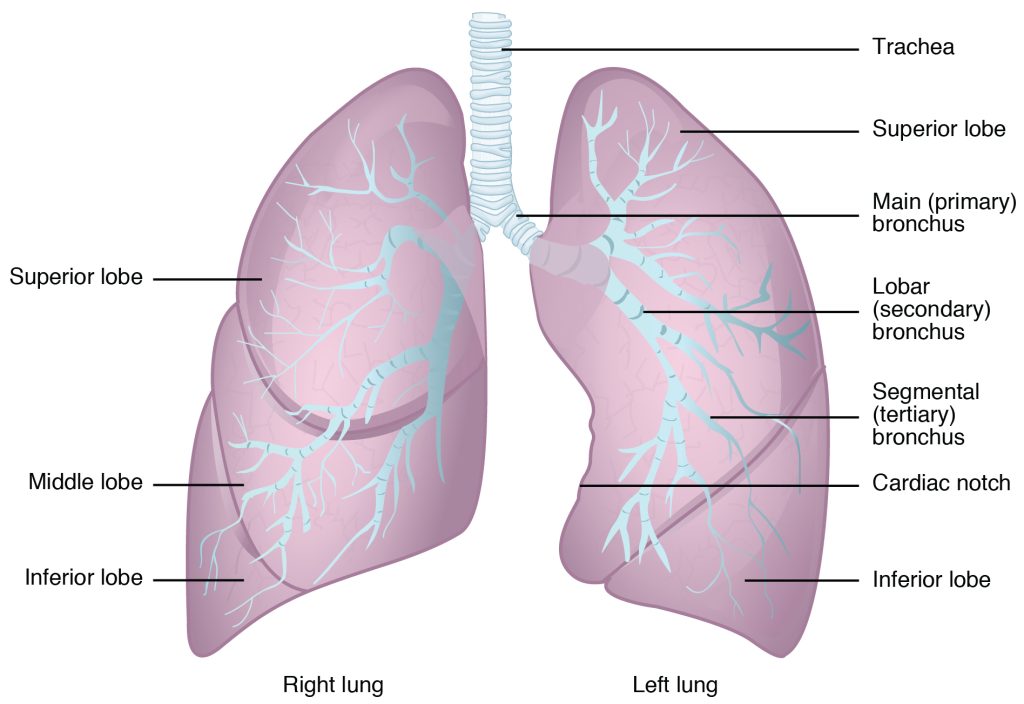
Each lung is composed of smaller units called lobes (lōbz). The right lung consists of three lobes: the superior, middle, and inferior lobes. The left lung is smaller and only contains two lobes, superior and inferior, as it shares space with the heart. Each lobe receives its own large bronchus that has multiple branches. A lobectomy (lō-BĔK-tŭ-mē) refers to surgical removal of a lobe of the lung.[22]
The word roots for lungs and/or air are pneum or pneumon. For example, the medical term pneumonia (noo-MŌN-yă) refers to a diseased state of the lung.[23]
There are two pleural membranes in the lungs. The visceral pleura is a thin membrane on the surface of the lungs. The parietal pleural lines the inside of the thoracic cavity. Between these two membranes is the pleural cavity that contains pleural fluid to reduce friction and also sticks to the lungs to keep them inflated. See Figure 4.9[24] for an illustration of the pleural membranes and the pleural cavity. Pleur is the word root for pleural membranes. For example, pleural effusion (PLOOR-ăl ĕ-FŪ-zhŭn) is a medical term that refers to excessive fluid between the pleural membranes caused by disease or trauma.[25]
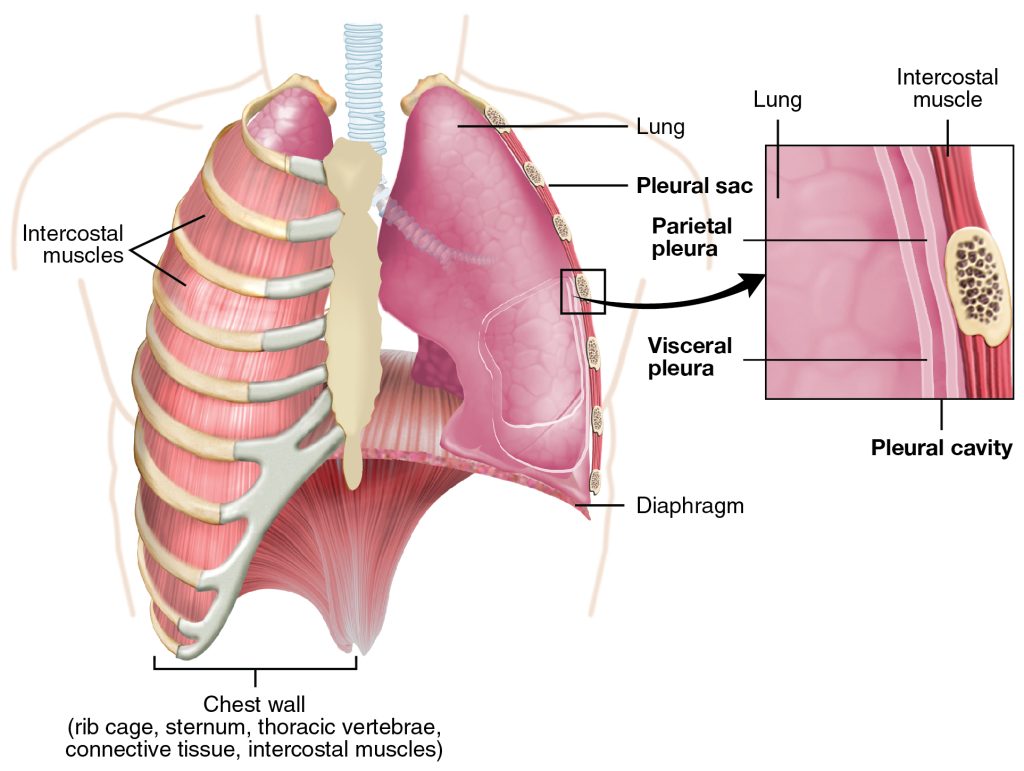
View the following YouTube video[26] to visually review the anatomy of the respiratory system: Respiratory System Anatomy (v2.0)
- “Blausen_0872_UpperRespiratorySystem.png” by Blausen.com staff (2014) is licensed under CC BY 3.0 ↵
- This work is a derivative of Anatomy and Physiology by OpenStax licensed under CC BY 4.0. Access for free at https://openstax.org/books/anatomy-and-physiology/pages/1-introduction ↵
- “2305_Divisions_of_the_Pharynx.jpg” by OpenStax College is licensed under CC BY 3.0 ↵
- This work is a derivative of Anatomy and Physiology by OpenStax licensed under CC BY 4.0. Access for free at https://openstax.org/books/anatomy-and-physiology/pages/1-introduction ↵
- This work is a derivative of Anatomy and Physiology by OpenStax licensed under CC BY 4.0. Access for free at https://openstax.org/books/anatomy-and-physiology/pages/1-introduction ↵
- This work is a derivative of Anatomy and Physiology by OpenStax licensed under CC BY 4.0. Access for free at https://openstax.org/books/anatomy-and-physiology/pages/1-introduction ↵
- This work is a derivative of Anatomy and Physiology by OpenStax licensed under CC BY 4.0. Access for free at https://openstax.org/books/anatomy-and-physiology/pages/1-introduction ↵
- “2306_The_Larynx.jpg” by OpenStax College is licensed under CC BY 3.0 ↵
- This work is a derivative of Anatomy and Physiology by OpenStax licensed under CC BY 4.0. Access for free at https://openstax.org/books/anatomy-and-physiology/pages/1-introduction ↵
- This work is a derivative of Anatomy and Physiology by OpenStax licensed under CC BY 4.0. Access for free at https://openstax.org/books/anatomy-and-physiology/pages/1-introduction ↵
- “2307_Cartilages_of_the_Larynx.jpg” by OpenStax College is licensed under CC BY 3.0 ↵
- This work is a derivative of Anatomy and Physiology by OpenStax licensed under CC BY 4.0. Access for free at https://openstax.org/books/anatomy-and-physiology/pages/1-introduction ↵
- “2308a_The_Trachea.jpg” by OpenStax Anatomy and Physiology is licensed under CC BY 4.0 ↵
- This work is a derivative of Anatomy and Physiology by OpenStax licensed under CC BY 4.0. Access for free at https://openstax.org/books/anatomy-and-physiology/pages/1-introduction ↵
- This work is a derivative of Anatomy and Physiology by OpenStax licensed under CC BY 4.0. Access for free at https://openstax.org/books/anatomy-and-physiology/pages/1-introduction ↵
- “2309_The_Respiratory_Zone.jpg” by OpenStax College is licensed under CC BY 3.0 ↵
- This work is a derivative of Anatomy and Physiology by OpenStax licensed under CC BY 4.0. Access for free at https://openstax.org/books/anatomy-and-physiology/pages/1-introduction ↵
- This work is a derivative of Anatomy and Physiology by OpenStax licensed under CC BY 4.0. Access for free at https://openstax.org/books/anatomy-and-physiology/pages/1-introduction ↵
- This work is a derivative of Anatomy and Physiology by OpenStax licensed under CC BY 4.0. Access for free at https://openstax.org/books/anatomy-and-physiology/pages/1-introduction ↵
- “2312_Gross_Anatomy_of_the_Lungs.jpg” by OpenStax College is licensed under CC BY 3.0 ↵
- This work is a derivative of Anatomy and Physiology by OpenStax licensed under CC BY 4.0. Access for free at https://openstax.org/books/anatomy-and-physiology/pages/1-introduction ↵
- This work is a derivative of Anatomy and Physiology by OpenStax licensed under CC BY 4.0. Access for free at https://openstax.org/books/anatomy-and-physiology/pages/1-introduction ↵
- This work is a derivative of Anatomy and Physiology by OpenStax licensed under CC BY 4.0. Access for free at https://openstax.org/books/anatomy-and-physiology/pages/1-introduction ↵
- “2313_The_Lung_Pleurea.jpg” by OpenStax College is licensed under CC BY 3.0 ↵
- This work is a derivative of Anatomy and Physiology by OpenStax licensed under CC BY 4.0. Access for free at https://openstax.org/books/anatomy-and-physiology/pages/1-introduction ↵
- Forciea, B. (2015, May 13). Respiratory system anatomy (v2.0) [Video]. YouTube. All rights reserved. Video used with permission. https://youtu.be/aqTwrdMS6CE ↵

